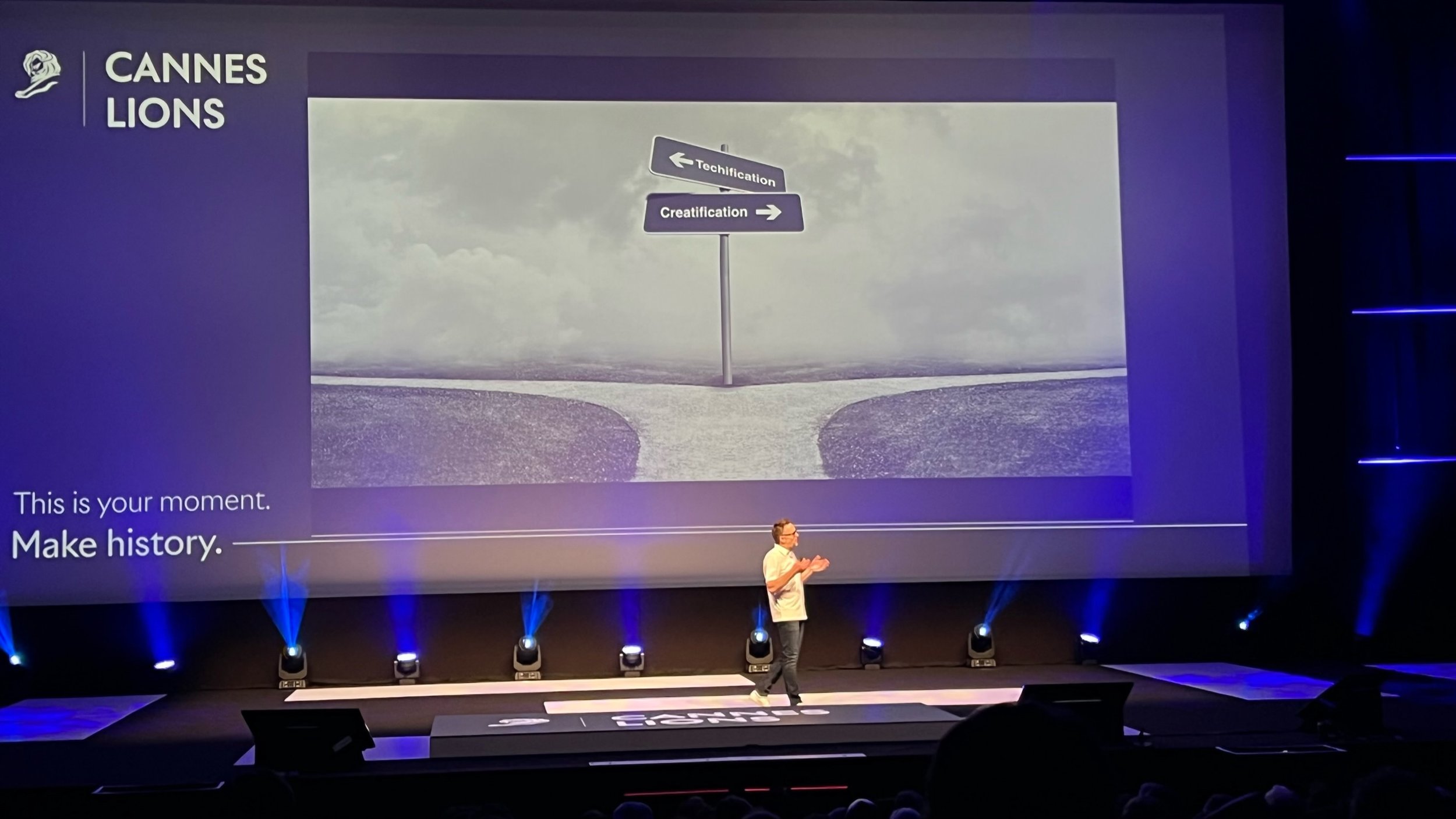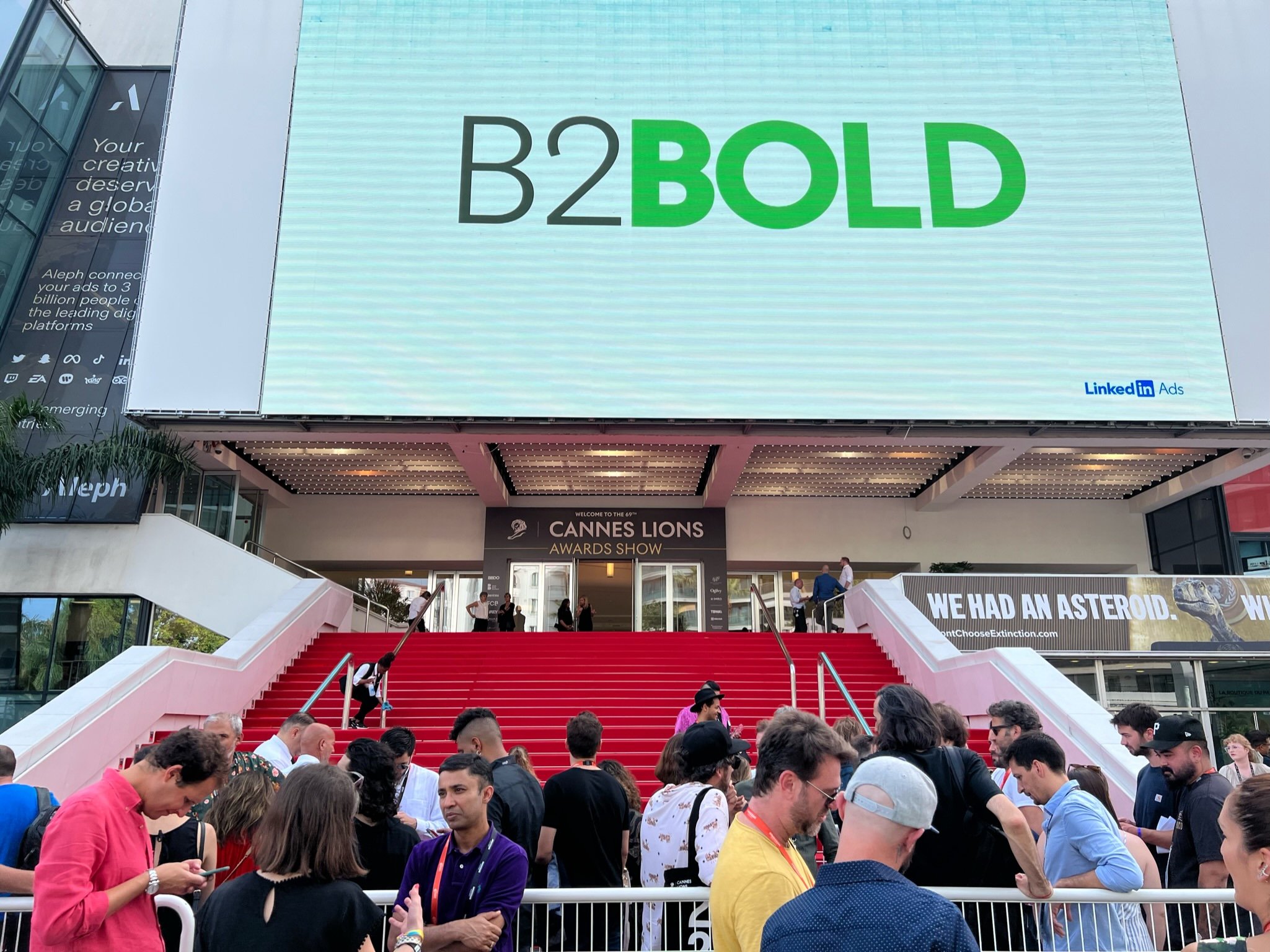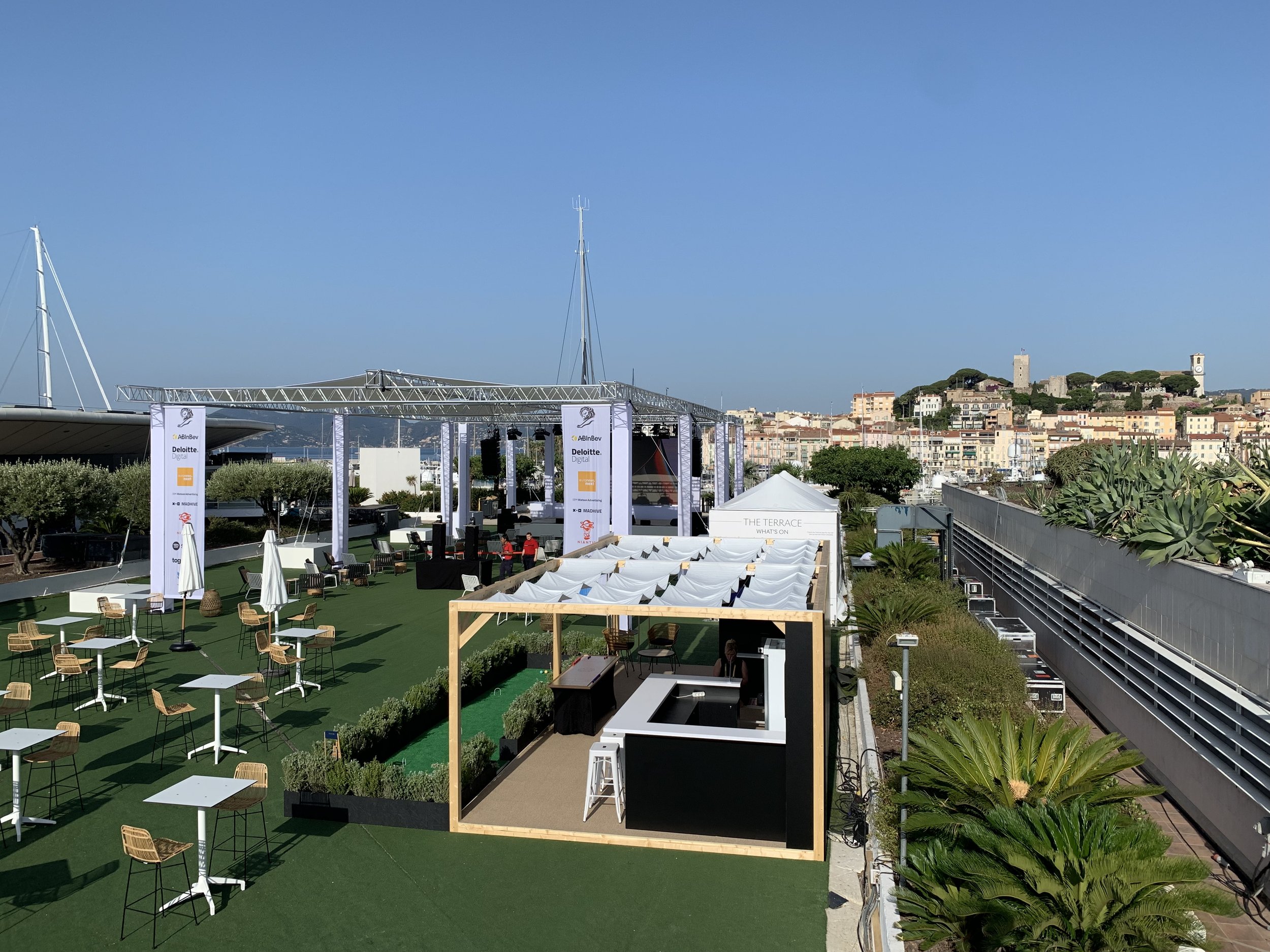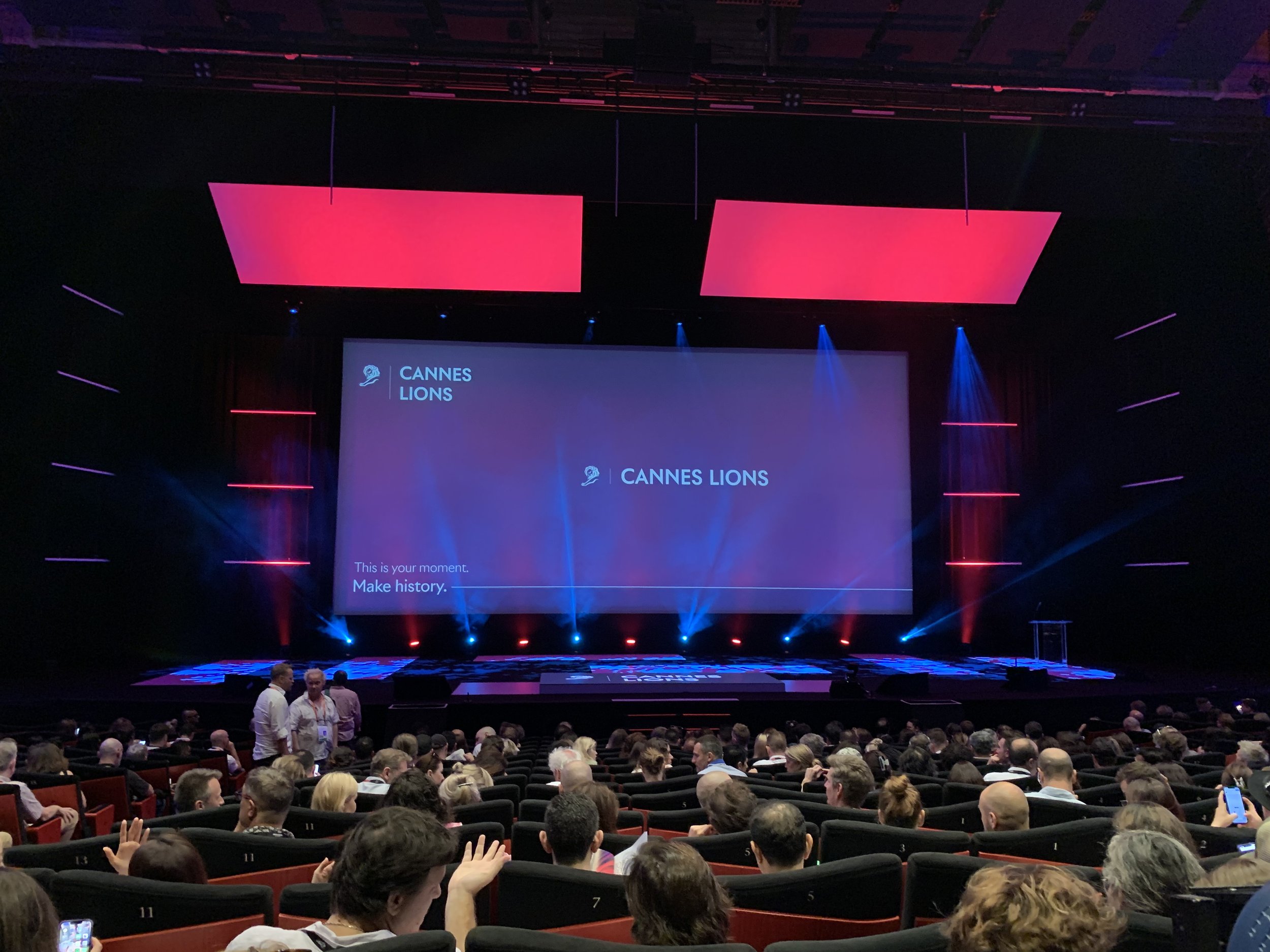Cannes Lions 2025: Hegarty Warns “Giants Can’t Dance” Without Cultural Courage
Stay ahead with Sir John Hegarty’s insights at Cannes Lions 2025. Discover how marketing and creativity must evolve to thrive in the AI landscape.
Sir John Hegarty and me at Cannes Lions 2025
At Cannes Lions 2025, Sir John Hegarty returned to the Croisette with a provocation that cut through the AI noise with characteristic clarity: size is no longer a competitive advantage—creativity is. Addressing a packed audience, the BBH co-founder made the case that legacy institutions are structurally ill-equipped to thrive in the AI era unless they undergo radical cultural reinvention.
“It’s not the big that beat the small or the small that beat the big. It’s the bold that beat the bureaucratic.”
This central thesis—delivered with Hegarty’s signature wit and steel—has clear implications for CMOs and agency leaders. As WARC has previously reported, organisational agility and creative bravery are outperforming traditional scale economics (a). Hegarty’s framework clarifies why bureaucracy and process, once the hallmark of durable enterprise, are now liabilities in a landscape shaped by speed, signal, and strategic improvisation.
The Collapse of the Creative Pyramid
Hegarty contended that the traditional triangle of leadership—where decision-making is concentrated at the top—is outdated. Instead, he offered the metaphor of the inverted triangle, where leadership serves from below, unlocking the distributed creativity of the organisation.
In the age of AI, everyone becomes a creative director. That shift necessitates more than upskilling—it demands a wholesale rethinking of structure, culture, and philosophy.
AI as Collaborator, Not Tool
Rejecting the reductive view of AI as a “tool,” Hegarty framed it as a collaborator. This nuance matters: AI can preserve and evolve founding philosophies, keeping a brand’s original vision relevant long after its originator is gone.
“Maybe one of the functions of AI is that the founder never dies.”
This reframing invites serious consideration from brand stewards. If AI can embody the sensibility and philosophy of a company’s origins—Chanel, Ford, Apple—then strategic brand leadership must shift from protecting the past to actively operationalising it in real-time.
Rebuilding from First Principles
For Hegarty, the path forward for large enterprises lies in rediscovering and reactivating their original philosophy. This rebuilding from first principles is not a nostalgic exercise. It is strategic regeneration. As he put it:
“Go back to what built you.”
This approach aligns with a trend WARC has observed in post-pandemic brand strategy: a return to essential values, often codified in founding principles, used as a compass for navigating transformation (b).
Hegarty cited Patagonia, Oatly, and Apple as examples of brands whose philosophies were not marketing lines but business doctrines—creatively interpreted through product, communications, and culture.
The Strategic Imperative for Brands
Hegarty’s presentation was a call to action, particularly for global brands under pressure to remain culturally relevant in a fragmented, AI-powered landscape. His advice:
Rethink structure: Flip hierarchies to empower bottom-up creativity.
Rediscover your philosophy: Make it central to innovation and brand behaviour.
Use AI to scale culture, not just content.
Stop aiming to be the biggest. Start aiming to be the boldest.
Final Thought
Sir John Hegarty may be a familiar voice at Cannes, but his message this year felt newly urgent. For organisations struggling to keep pace, his challenge was simple: either dance or die. And in the AI era, the pace is only accelerating.
I have recently completed the Creativity for Growth Course. It was a brilliant opportunity for insight and learning from an industry legend.
Sources:
(a) Building Belief: What It Takes to Instill a Culture of Creative Effectiveness
(b) WARC Asian Strategy Report: Staying relevant amidst changing tides
Published on June 25, 2025, at anthonykennedy.com
Setting the pace
In my transition into a senior marketing leadership role, I know the importance of not wasting time and working with experienced pacemakers to have a positive impact and deliver results. I am participating in the Cannes Lions CMO Accelerator program and am looking forward to working with industry leaders and professionals to set the pace for success.
"The pacing team isn't an accident. It's a choice." – Seth Godin
With my transition into a senior marketing leadership role, some things have become more precise and critical.
- I do not have the 30 cycles that Mark Ritson speaks of for a marketer in their 20's Call to Action podcast(Episode 100). While I've already worked 20-plus cycles, I have 15 more to own and deliver.
- Knowing the appalling state of implementation, delivery, structure and framework, efficiency, and approach across the industry as regularly reported in Marketing Week and [Marketing Professionals] (https://www.marketingprofs.com/cmp/stateofb2b/22report/sa/#), I do not have time to waste not to do this properly the first time.
- I want to have an impact; that's one of the reasons why our in-house agency is called Impact, and we deliver results now. So, as per Seth Godin's Choosing your pacemaker, I must link myself to experienced and professional pacemakers.
I am pleased to have semi-regular arms-length access to Mark Ritson and the brilliant teams at Xeim in London. I am excited to return to Cannes for the Lions Festival in a few weeks.
Fortunately, I am a part of the Cannes Lions [CMO Accelerator programme] (https://www.canneslions.com/initiatives/cmos/cmo-accelerator-programme-2023) for senior marketers this year. I look forward to working with Jim Stengel, Suzanne Tosolini, Gary Vaynerchuk and the Cannes Lions education team.
The pace set by Mark, Jim, Suzanne, Gary, and Cannes Lions will be fast and just the speed I need to deliver results and make a positive Impact.
Day two: Cannes Lions 2022
Day two at the Cannes Lions International Festival of Creativity was the busiest plan of my week, with eight sessions across talent, change, ESG, and user experience.
Day two at the Cannes Lions International Festival of Creativity was the busiest plan of my week, with eight sessions across talent, change, ESG, and user experience.
LinkedIn and the fight for great talent
Ryan Roslansky, LinkedIn CEO, walked us through changes impacting the fight for great talent with a focus on the advertising industry. Based on LinkedIn's social graph knowledge from 830 million members and 57 million companies. Ryan said that Gen Z moves more frequently than other generations, followed by Millenials, Gen X, and Boomers. He also showed the change in roles within the Advertising industry now requiring tech skills, a 25% increase, and tech skills are becoming table stakes as part of the global arms race for tech talent.
He spoke about storytelling and the invention of the term horsepower by Scottish Engineer James Watt.
"Using a complicated mathematical equation, Watt deduced that a mill horse could push 32,572 pounds one foot in a minute, which he rounded to an even 33,000 pounds. 33,000 pounds pushed one foot in a minute. The power of one horse. One horsepower!" (The Chronicle of the Horse, https://www.chronofhorse.com/article/james-watt-and-revolution-horsepower)
Watt found a way to translate scientific measurements into a unit of measure that people could relate to - that of horsepower. Horsepower was a promise of what the steam engine could do. Ryan reinforced that we are in a promise-making business and must make promises, but promises we deliver. Apple did this with the 1,000 songs in your pocket slogan introduced by Steve Jobs 21 years ago in 2001.
Brand activism - Your power as marketers to make big change
A recent study of the top 50 brands approximated that they have 72 billion opportunities to influence consumers through the sales process for their products. This means that marketers have the opportunity to have a professional purpose with the chance of having a planetary impact.
In Diageo, at Guinness, they have adopted a three-pronged approach to sustainability around reinvention, restoration, and reduction.
What can you do to reinvent how you operate?
What can you do to restore the ecosystems in which you operate?
What can you do to reduce the destructive impact across the supply chain?
How can we make a change to the way that we think and the decisions we make to fundamentally change how we approach and value the impact our actions have on the environment.
Leveraging machine learning and augmented reality for experiential digital commerce
Jeremi Gorman, Chief Business Officer at Snap Inc, showcased some of the most important features available in Snap that leverage machine learning and augmented reality for experiential digital commerce. Every day more than 250 million people engage with augmented reality in Snap. Snap view themselves as a camera company and they have used technology to extend the user experience. She said that 250 million people have already tried on 5 billion products digitally.
Robert Triefus from Gucci spoke about Gucci's deep belief in digital and he encourage everyone to lean into digital hard. Gucci have used digital to expand their community and to bring new kinds of experiences to their customers. Technology also enables Gucci to give their customers a unique experience across different channels, empowering their community to express creativity, and to provide insights to the business.
A camera is a catalyst to personal creation centering the world around the user authentically. This makes cameras and digital experience a part of the future of personal storytelling with the user an active participant in creating the future.
Break the standard leading business creation with unique experience
The design team from Minna Bank in Japan spoke about how they worked to change from business leading experience to experience leading business.
Taehan Yoo, Design Director, spoke about how many times we copy and paste a design, experience, or idea for safety. But once we have copied and pasted and made our expeirence the same as others the consumer then wants the cheapest experience and this takes us to a place we don't want to be.
At Minna, which means everyone in Japanese, they're focussed on delivering a new approach to digital banking, primarily for digital natives in the Generations Z, Y, and Millenials. Minna's users are 70% from these generations, vs traditional banks whose users are 70% from older generations. [There is a video showcasing Minna bank here](https://youtu.be/irKyj-EpTzQ).
The team of designers were very passionate about their approach to understanding their customers and delivering a frictionless experience. Many of the things they spoke about the experience of banking I could relate to from my own experiences with [N26 in Germany](https://youtu.be/IWwrfkkM4iI), and [Starling Bank](https://youtu.be/E7F7s7AOFNk) in the UK who both deliver a similar frictionless digital experience.
The most interesting thing I learned today was from Snap. When Snap added the weather feature to Snap to add the current weather in as the background to a photo people engage with it and activated the feature millions of times, but didn't save the photo. Snap discovered that people were using their camera as their weather app, and were inserting the weather to get the metrics. So Snap expanded the tool to include a multi-day forecast.
A full day with a lot of ideas around using creativity for growth, and for change.
#CannesLions2022 #IONatCannes
Day one: Cannes Lions 2022
My first day at Cannes Lions was action-packed, starting with Gary Kasparov and the Regain Ukraine brand using the power of creativity to support Ukraine in the war with Russia.
My first day at Cannes Lions was action-packed, starting with Gary Kasparov and the Regain Ukraine brand using the power of creativity to support Ukraine in the war with Russia.
The next session was with award-winning CMOs from AB InBev and Microsoft. Marcel Marcondes, AB InBev Global CMO, spoke about building great brands and that 'without trust, there is no greatness'. Trust takes time to develop, and I believe that it must be a goal that is a foundation for what you do. Kathleen Hall from Microsoft, who won the Cannes Lions Creative Marketer of the Year in 2021, spoke about the creative work Microsoft has done on inclusion in Gaming with new devices and controllers for differently-abled people. It was inspiring to see people transform when they could play like their friends using these devices for gaming and learning.
I then worked in a group led by Cindy Gallop on rebuilding the Agency model. I admire Cindy as an intelligent and thoughtful leader who, in her own words, 'likes to blow shit up. Cindy broke us out into six teams to build our agency based on new rules without reference to out-of-date models. This session was with talented specialists making a case for what is needed to achieve these goals. There are lessons I will take back with me to use with my teams.
We were then introduced to four creative industry members from Ukraine whose worlds have been turned upside down since February 24, when Russia invaded Ukraine—hearing the stories of people who lived exactly as we do in a modern European nation now suffering a war in Europe and their experience of 'creativity under bombs'. We were fortunate to be surprised with a special guest, Volodymyr Zelenskyy, President of Ukraine. Zelenskyy spoke about how this group of Marketing and Communications leadership could help Ukraine win the war by using branding as a tool and a weapon. Brave Ukraine is a brand to build, retain, and expand awareness of the atrocities being done daily in Europe.
The creative, brand, and marketing leadership of Nike then showcased three different approaches to working with your users to produce great results. The team from Nike spoke about how every one of us is an athlete. They did not talk about users or customers but athletes. The focus on the athlete is a vital part of the vision about who they serve and what they do for athletes. I learned about the goal of achieving the first sub-two-hour marathon and focusing on making products that deliver for athletes. Eliud Kipchoge of Kenya covered 26.2 miles in 2 hours 25 seconds - just 26 seconds short of the goal. The team then showcased the value of crazy dreams and checking if your goal isn't yet crazy enough to deliver the change you want. I have an action item to review my own goals. Finally, the team showcased the difference that can be achieved to normalise through cultural awareness and the introduction of clothing, and equipment to solve bespoke needs for groups such as pregnant women, Muslim women, and other athletes and the impact this can have on civil society.
Today I managed to make it to one of the secret speaker sessions. The speaker was AY Young, and I was introduced to him with a fist bump. AY sang, danced, spoke, and inspired a room full of creatives, communication, and marketing specialists through his work as a Young Ambassador Envoy for the United Nations and the 17 Development goals. It’s not easy to have a room full of grown adults singing, ‘we can change the world’. AY is an inspiring young performer focused on improving the world by delivering the 17 Development Goals of the United Nations. Do you know what? We can change the world, and we are the only people who will do it.
We organised the day's sessions with the Geena Davis Institute on Gender in Media. Founded initially to monitor and rebalance gender and gender roles in the media, their research now examines the intersectional onscreen representation of six identities: gender, race, LGBTQIA+, disability, age 50+, and body type. In many areas, there has been significant improvement in the representation of these identities in essential roles, including speaking and being in leadership positions. I will take away ideas from this as a framework to better present all of us.
This was a huge day with a massive amount of discussion, learning, and reflection on the power of creativity to change the world. As a creative leader, I believe we can change the world.
#CannesLions2022 #IONatCannes










